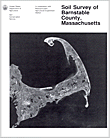The following is a map unit description from the "Soil Survey of Barnstable County, Massachusetts (Fletcher, 1993)"

CcB-Carver loamy coarse sand, 3 to 8 percent slopes. This very deep, gently sloping, excessively drained soil generally is in broad areas on outwash plains but is also in areas of sandy glacial lake deposits. It makes up approximately 5.1 percent (12,888 acres) of the survey area. It is mapped mainly in the Enfield-Merrimac-Carver general soil map unit. Areas are irregular in shape and range from 5 to 200 acres in size.
Typically, the surface is covered with an organic layer. This layer is about 2 inches of loose, undecomposed pine needles, leaves, and twigs and 1 inch of matted, partly decomposed and well decomposed organic material. The surface layer is light brownish gray, very friable loamy coarse sand about 3 inches thick. The subsoil is coarse sand about 33 inches thick. The upper 1 0 inches is strong brown and very friable, the next 9 inches is yellowish brown and very friable, and the lower 14 inches is brownish yellow and loose. The substratum to a depth of 65 inches or more is light yellowish brown, loose coarse sand.
Included with this soil in mapping are small areas of Eastchop, Enfield, Hinckley, and Merrimac soils and areas where slopes are less than 3 percent or more than 8 percent. Included soils make up about 20 percent of this unit.
Most areas are used as woodland. Many areas have been developed for homesites, and a few areas are farmed.
This soil is poorly suited to cultivated crops. The low available water capacity and the susceptibility to erosion are management concerns. Irrigation is needed for most cultivated crops. Mixing plant residue and manure into the surface layer increases the available water capacity. Farming on the contour or across the slope, terracing, stripcropping, including grasses and legumes in the crop rotation, growing cover crops, and applying a system of conservation tillage help to control runoff and erosion.
This soil is poorly suited to hay and pasture. The main management objective is the prevention of overgrazing, which reduces the hardiness and density of desirable plants. Proper stocking rates, timely grazing, and restricted use during wet periods help to maintain plant density and minimize surface compaction.
Because of the droughtiness, this soil is poorly suited to woodland. Thinning dense stands to standard stocking levels results in more vigorous tree growth. Diseased, deformed, and otherwise undesirable trees should be removed when the stands are thinned. The most common trees are pitch pine, scrub oak, scarlet oak, and white oak. Generally, these trees are of poor quality and seldom attain heights of more than 35 feet.
Few limitations affect the use of this soil as a site for buildings with or without basements. The droughtiness is a limitation affecting lawns and shallow-rooted trees and shrubs. Adding a layer of topsoil and frequently watering during dry periods help to overcome this limitation.
This soil readily absorbs but may not adequately filter the effluent in septic tank absorption fields. The poor filtering capacity may result in the pollution of ground water. The hazard of pollution increases with the density of housing. Precautionary measures may be necessary in some areas.